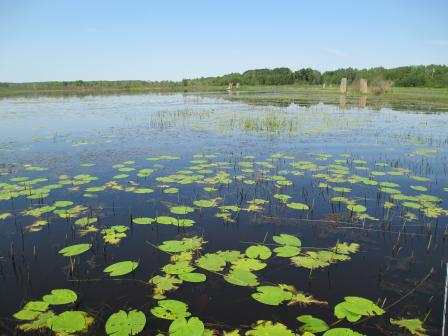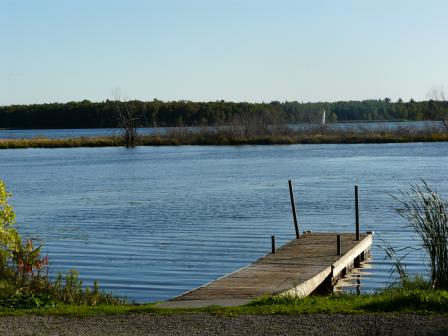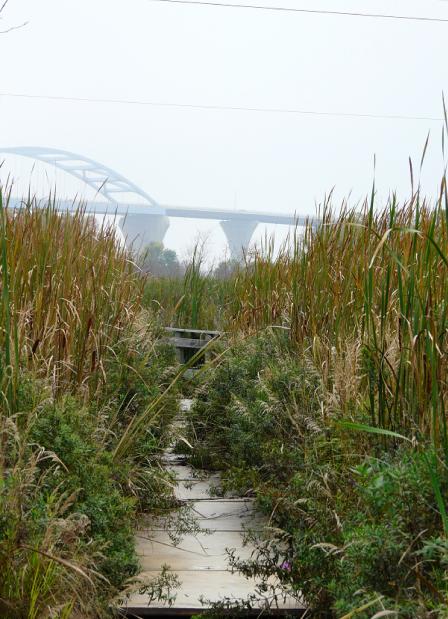Helping Preserve and Promote the Cultural Significance of Kingsbury Bay and Grassy Point
Published November 1, 2018; Updated July 1, 2019
 The St. Louis River.The cities of Duluth, Minnesota and Superior, Wisconsin, and the Fond du Lac Band of Lake Superior Chippewa reservation are all situated at the western end of Lake Superior, along the St. Louis River where it flows into the lake. The St. Louis River mouth forms a natural harbor that is home to both the largest freshwater port in the world and a 12,000-acre freshwater estuary which provides important habitat and supports a variety of cultural and recreational activities. Notably, in the center of the freshwater estuary is Spirit Lake. Spirit Lake is a sacred place to the Ojibwe people because it was among the stopping places during their westward migration, and provided abundant wild rice. After European settlement, the St. Louis River suffered from a legacy of pollution by poorly controlled municipal and industrial wastes, and widespread habitat loss. Through the Great Lakes Restoration Initiative, EPA has been addressing these legacy impacts, and in recent years, there has been tremendous progress in restoration.
The St. Louis River.The cities of Duluth, Minnesota and Superior, Wisconsin, and the Fond du Lac Band of Lake Superior Chippewa reservation are all situated at the western end of Lake Superior, along the St. Louis River where it flows into the lake. The St. Louis River mouth forms a natural harbor that is home to both the largest freshwater port in the world and a 12,000-acre freshwater estuary which provides important habitat and supports a variety of cultural and recreational activities. Notably, in the center of the freshwater estuary is Spirit Lake. Spirit Lake is a sacred place to the Ojibwe people because it was among the stopping places during their westward migration, and provided abundant wild rice. After European settlement, the St. Louis River suffered from a legacy of pollution by poorly controlled municipal and industrial wastes, and widespread habitat loss. Through the Great Lakes Restoration Initiative, EPA has been addressing these legacy impacts, and in recent years, there has been tremendous progress in restoration.
 Kingsbury Bay.While restoring water quality of a polluted river increases the well-being of the surrounding community, sometimes these efforts can have unintended health consequences. To help avoid these consequences, EPA researchers use the Health Impacts Assessment (HIA) process to investigate how a program, policy, plan, or project may unintentionally impact health and well-being and then provide this information to the decision-makers before decisions are made.
Kingsbury Bay.While restoring water quality of a polluted river increases the well-being of the surrounding community, sometimes these efforts can have unintended health consequences. To help avoid these consequences, EPA researchers use the Health Impacts Assessment (HIA) process to investigate how a program, policy, plan, or project may unintentionally impact health and well-being and then provide this information to the decision-makers before decisions are made.
EPA researchers used the HIA process in the St. Louis River Area of Concern (AOC) to examine potential public health impacts of coastal wetland restoration work and park improvement projects at two project sites along the St. Louis River–Kingsbury Bay and Grassy Point that are owned by the City of Duluth and managed as community park space. The project was selected in part because of the opportunity to enhance cultural resources in and around the river. Kingsbury Bay borders Indian Point campground, a culturally significant place because it was an early Ojibwe camp site. Also, the restoration provided an opportunity to restore wild rice and medicinal plants, and provide interpretative information in the park about the cultural and spiritual value of these plants. Results of the assessment were provided to the Minnesota Department of Natural Resources and the City of Duluth to inform their decisions regarding the design and implementation of the improvement projects.
 A dilapidated boardwalk at Grassy Point.EPA researchers used the HIA process to look at factors that impact human health, also referred to as determinants of health. These include:
A dilapidated boardwalk at Grassy Point.EPA researchers used the HIA process to look at factors that impact human health, also referred to as determinants of health. These include:- individual factors like age and genetics;
- individual behaviors like diet and exercise;
- public services like health care and education;
- living and working conditions like air, water, and soil quality; and
- social, economic, and political factors like poverty, inequality, and social cohesion.
Some determinants of health are harder to measure than others. For example, the Kingsbury Bay and Grassy Point natural areas have traditionally provided space for spiritual reflection and other tribal uses for the Native American communities in the area. Because of their spiritual connection to the river, the Fond du Lac Band was an important partner to engage to understand the connection between restoration and well-being. With guidance from the Fond du Lac Band, EPA researchers mapped the areas with significant spiritual meaning so that the assessment could take into consideration the impacts these restorations might have on those areas. EPA researchers also determined which areas which would be suitable as wild rice habitat post-restoration to assist tribal resource agencies with plans for wild rice restoration at the project sites. By working with Fond du Lac Band members, tribal resources, culturally significant places, and traditional ecological knowledge were incorporated into the assessment.
The analysis found that construction will temporarily and minimally detract from health by limiting access to these spaces for social and cultural use. However, once construction is complete, the natural space will benefit health by providing an opportunity for the public to enjoy the area as a site for social interaction, spiritual reflection, and cultural resources, such as the restoration of wild rice production and viable populations of medicinal plants.
Recommendations
Based on input from stakeholders, community members, and scientific experts, the HIA process provided several recommendations to improve the health-related outcomes of the project. First, the planners should conduct stakeholder meetings to better understand the social significance of these parks. They should also consult with the 1854 Treaty Authority, an inter-tribal natural resource management organization, and Fond du Lac Band resource managers to identify significant sites and determine the best approach to preserve, enhance, or understand resources.
While making decisions on the future designs of the restored areas, planners should strive to create natural spaces for social interaction and solitary spiritual reflection. They should try to develop spaces for spiritual reflection that minimize the noise and distraction from the nearby industry. They should consider using signs to mark culturally significant spaces that promote quiet reflection. The planning team should prioritize planting native, medicinal, and culturally significant plants and promote the presence of culturally significant wildlife and an abundance of fish for subsistence fishing.
By preserving, promoting, and respecting the cultural and religious significance of these natural spaces and their species, the overall health and well-being of area residents, including indigenous communities in and near Duluth, can be further improved.
Work on this restoration project began summer 2019. View more information from Minnesota's Department of Natural Resources. Exit
